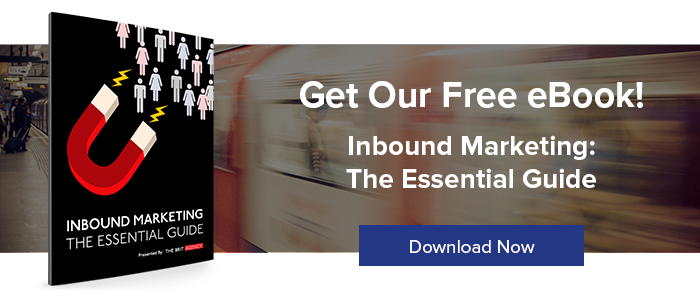Implementing a website that is designed especially for B2B lead generation, can have a significant impact on the overall success of your Inbound Marketing program.
The best way to design a new website, with the most Inbound program performance impact, is to practice, what we call, Inbound Website Design. This is a new, more thoughtful way to create a website, so it can work harder for you, and do the job - to attract more traffic and convert more leads.
As Inbound Website Design is a relatively new concept for many marketers, I'd like to explain what an Inbound Website is in more detail, specifically for the B2B market.
I've noticed over the years that many B2B marketers have strategies for their marketing, that exclude their website. This particularly applies to traditional B2B companies who still have older websites, created many years ago as a website brochure, that just displays their products or services, without any regard for SEO or lead generation.
In fact, the marketing program and the website have to be totally connected and be quite inseparable, under one strategy, especially if you are practicing B2B Inbound Marketing.
A website is actually so important, that it should be at the centre of your B2B Inbound Marketing strategy — a hub if you like, for all of your marketing activities. It should be a complete traffic and lead generation platform, with your marketing strategy baked right in, and it shouldn't be regarded as a cost, but as an investment that can prove its own value and ROI by delivering leads.
A B2B Inbound Website is therefore, a website that's designed around Inbound Marketing, and specifically targeted at your buyer persona. The goal is to attract them to your website, to give them a positive user experience, provide them with content they may be looking for, and hopefully convert them into a qualified lead. When, this is implemented, a fully functioning Inbound Website can become the hub for your entire Inbound Marketing strategy.
Therefore, it makes sense that your B2B Inbound Marketing strategy, your visitors website experience, and the way you manage your lead generation funnel using marketing automation technology (such as HubSpot) - are all critical to the way a website is designed and developed.
Let's dive a little deeper, here are some of the unique features of a B2B Inbound Website, and how it can help improve your Inbound Marketing program.
1. A B2B Inbound Website Is Specifically UX Designed For The Buyer's Journey
An Inbound Website not only has to look fabulous and make the user experience brilliant, but it also has an important job to do - it has to be optimized to attract the best possible website traffic, it has to convert that traffic into qualified leads, as well as nurture those leads into sales opportunities.
To do this really well, you have to know your buyer's persona, your buyer's journey, and have the content they're looking for properly mapped and located at the right stage of their journey.
An Inbound Website will leverage good UX design to accomplish that goal. UX design refers to user experience design, and is needed for your Inbound Website, so it can be fully functional, and take advantage of delivering the right messaging, to your buyer persona.
The goal with UX design is to guide the website visitor around the website according to your requirements of your Inbound Marketing strategy, making the website site experience positive. The website will need to be clean, easy to navigate, with good use of white space, quality images and content, with no clutter, no redundant information, or distractions.
2. A B2B Inbound Website Is A 24/7 Conversion Funnel
This is where the Inbound Marketing layer has to be added to your website. By adding a conversion funnel you will be able to start converting website traffic into leads. To do this you will have different website design elements and assets to use so you can attract, convert, close, and delight customers.
Don’t just think about website design aesthetics, it should look good of course, but you should also consider functionality, too.
Ideally, the website design follows the Inbound Methodology, each click on your website should have purpose, and should be logical and clearly defined, with one page leading to the next, as you move users further down their buyer's journey.
Your conversion funnel should therefore be the driving force for your website, and should dictate your website’s organization, assist the buyer's journey and create user pathways, which should include:
- Content - Of course, the website design is important, but website content is even more important. Understanding your keywords, writing an ongoing blog, and managing search engine optimized website pages are a must, but you should also consider adding value-based content offers such as white papers, tip sheets, e-books, videos, webinars, infographics, demo's and possibly podcasts. The more content you add to the site with the better your results will be over time.
- Calls-to-Action (CTA's) - An Inbound Website will have content offers throughout the website speaking to each buyer persona and each persona buyer's journey. You need to use CTA's progressively, to move people down your marketing funnel and convert them into leads.
- SEO - An Inbound Website needs organic traffic, and it won't do its job if you don't do SEO. Don't forget about ongoing SEO tasks that need to be done to anything new you add to the site.
- Conversion Points - Critical conversion elements, need to be added to your website like landing pages, thank you pages, calls-to-action, automated drip emails, all designed to help convert visitors into leads.
- Personalization - This takes an Inbound Website to the next level. By using smart forms, personalization and contextual marketing elements, all of these can be used to gather lead intelligence from your website visitors, by asking them more questions and auto delivering personalized content, so you can better nurture leads and eventually close them into customers.
3. A B2B Inbound Website Can Nurture Leads Along The Buyers Journey
Did you know that buyers complete more than half of the buyer's journey before even talking to someone in sales? This means that your buyers are already researching and deciding on solutions long before they need to speak to a sales rep. So your website has to help educate buyers throughout the sales cycle, from the top of the funnel, to the bottom of the funnel, and the provision of that content is critical.
With a traditional website, you may publish basic information about your products and services, then, you wait for your website visitors to visit the "Contact Us" page and place a call to you. With an Inbound Website, you nurture leads gradually, from first touch to final purchase.
Your website defines the content for the buyer's journey, the three stages that buyers take before purchasing a product. (See previous blog - "The Buyer's Journey - Unplugged")
- Awareness — Persona is aware they have a problem, and they're looking to identify and understand it.
- Consideration — Persona becomes aware of potential solutions (including your product or service!) They actively seek to understand these solutions better, and need more information.
- Decision — Persona is fully bought into the solution, hopefully it's your solution, and so they now need to decide where, when, and how to purchase.
By setting your content throughout the buyer's journey on your website, you write the narrative of first how and then why your solution is the best for that persona's problem.
That makes you present for that “zero moment of truth,” the critical moment when people are researching and deciding on where (and how) to purchase. Without such a content strategy, your B2B business will have a hard time generating leads online and driving sales.
4. B2B Inbound Websites Are Constantly Being Improved For Better Optimization And Conversions
Chances are, if your website isn't evolving and improving all the time, you're missing out on leads and sales.
That's the genius of a growth-driven design (GDD) - the process for continual website improvement.
Inbound Website Design and GDD - go hand-in-hand, making GDD, the process of continual website improvement, a fundamental part of the B2B Inbound Website Design model.
You wouldn't ignore your marketing for a year, let alone a month... so you shouldn't let your website gather dust either. Instead of yearly website refresh and redesign projects, you can invest in ongoing, monthly changes, updates and improvements to your website design and strategy, promising ongoing improvements to your website performance.
Here’s how we do it:
Your Inbound Website is analyzed for specific performance metrics - keyword performance, % conversion rates, content conversion, heat maps, CTA button clicks, pop-up usage, UX design organization, landing page performance etc., all this data will analyze the buyers journey performance - asking the question - Is the website delivering the performance we expect?
We use a variety of tools to track and measure all aspects of a websites performance, we implement user testing, and closely watch performance metrics in Google Analytics, and HubSpot.
In response to this data, we make improvements to the website, ideally, on a monthly basis. Then, repeat!
You’re not waiting for the next redesign to roll around to make improvements and fix problem areas, your website is constantly showing its best face to buyers, and it's converting at a higher rate, it's better optimized, and it's doing its job.
In conclusion, your Inbound Marketing strategy and your Inbound Website, must be strategically working very closely together to get the best possible Inbound results. By designing the website using the disciplines of Inbound Website Design you will have an excellent foundation on which to track and measure performance, and then with a program of continual website improvement - your website traffic, leads and ROI will definitely improve.
THE BRIT AGENCY is a B2B Inbound Marketing Agency providing Inbound Marketing, Inbound Website Design and Inbound Sales services to companies around the world. We're focused on growing website traffic, qualified leads and sales, using the Inbound lead generation and marketing automation process.
THE BRIT AGENCY is a certified Gold Tier Hubspot Partner, a HubSpot COS certified Inbound Website Design Agency, a Shopify eCommerce Partner, and a certified "Google Badged Agency Partner". We have offices in Toronto and Barrie, Canada, and Salisbury, UK.


